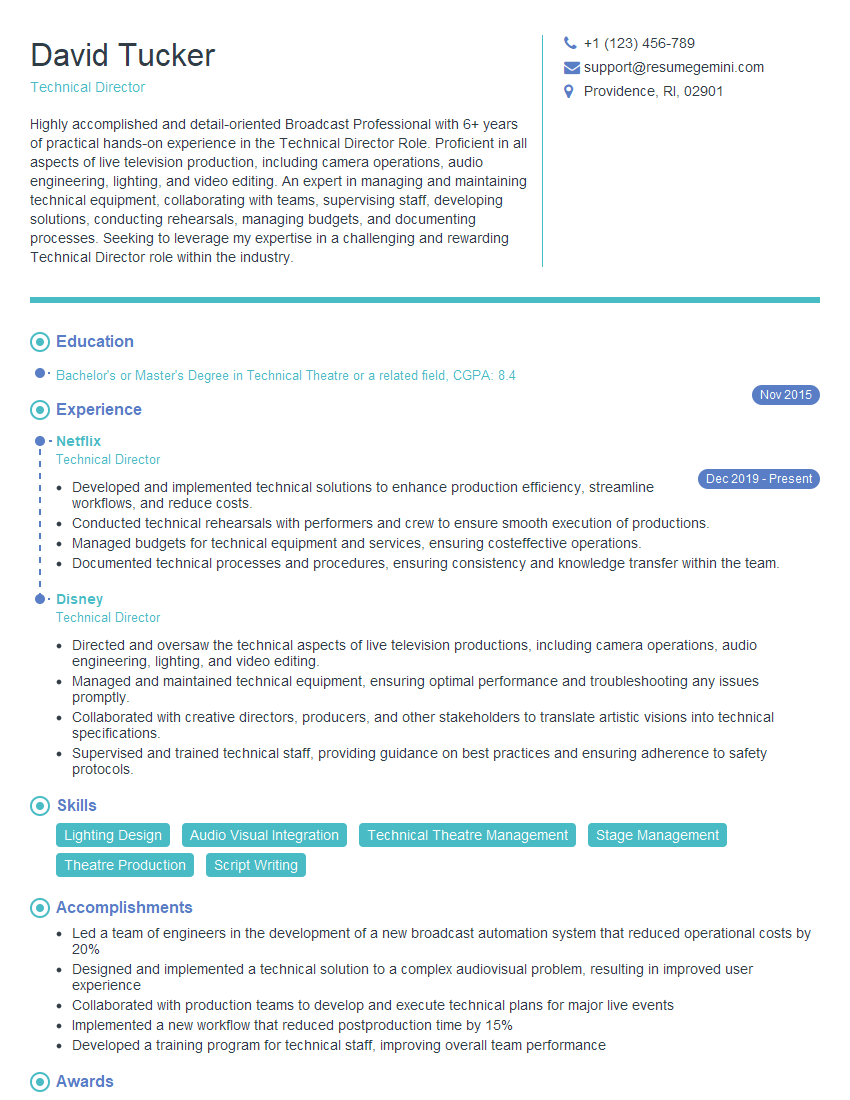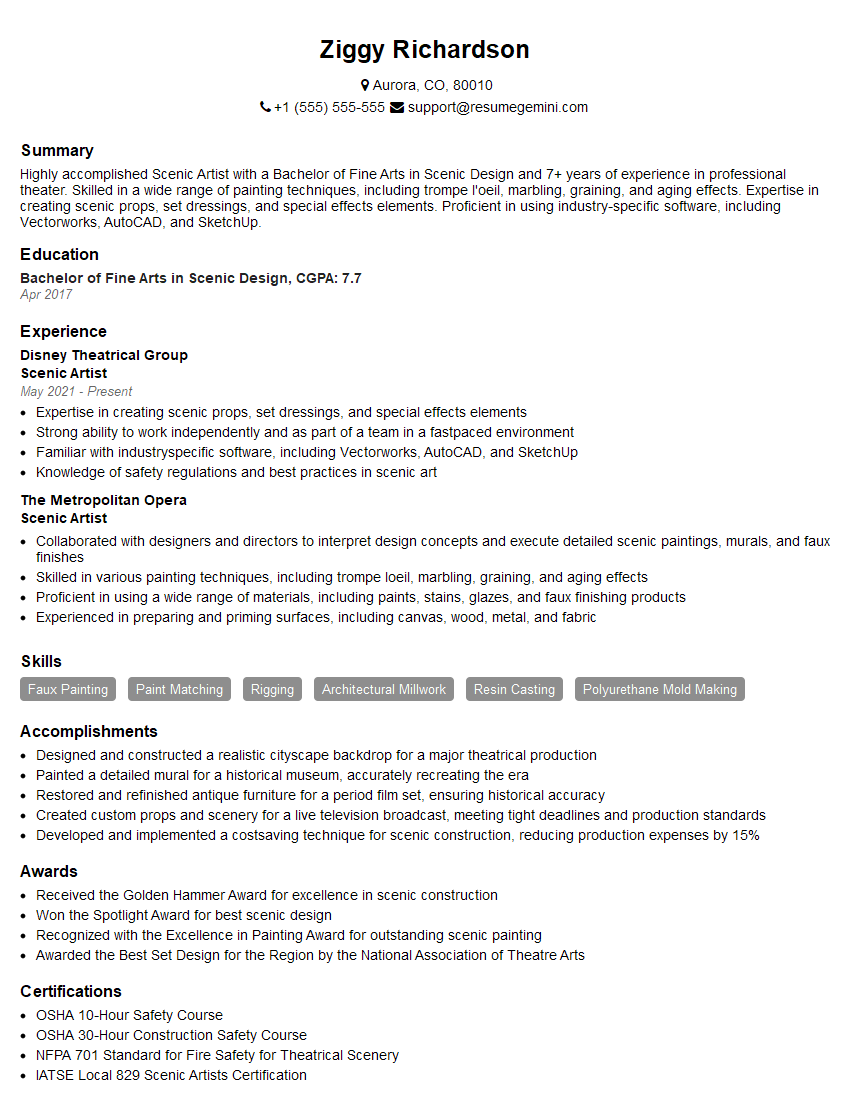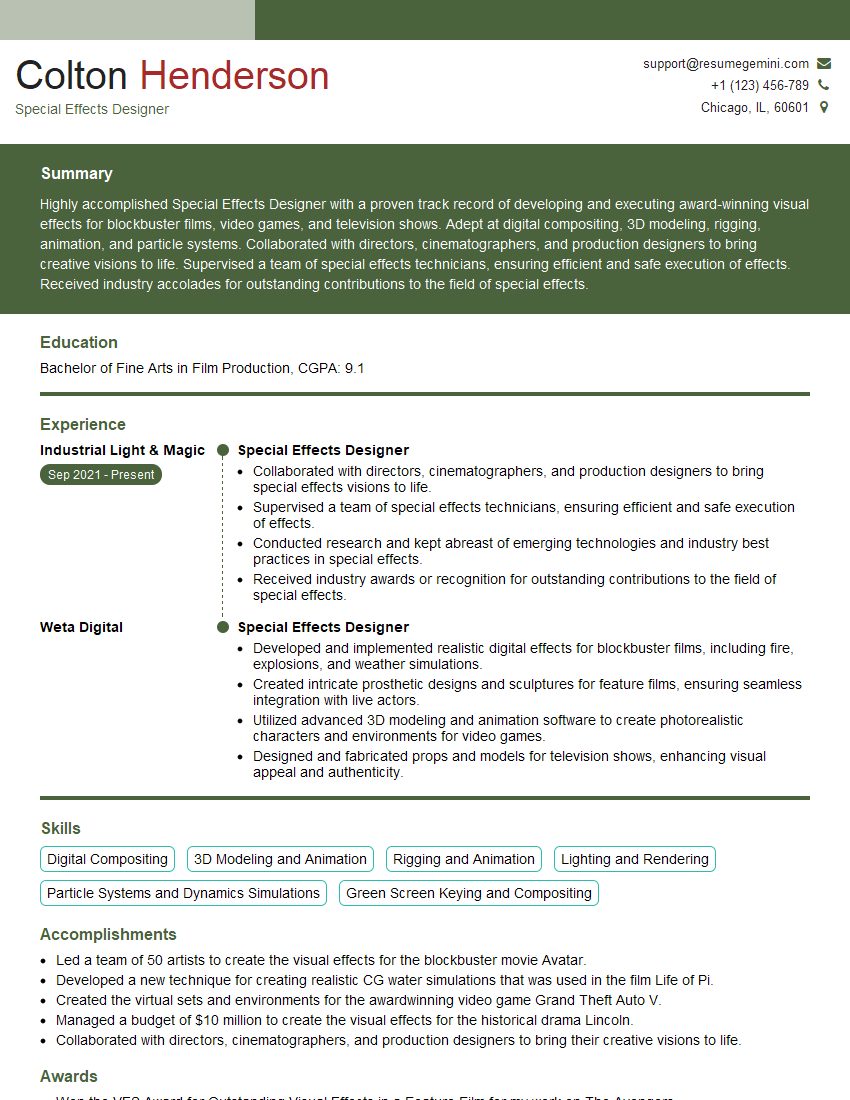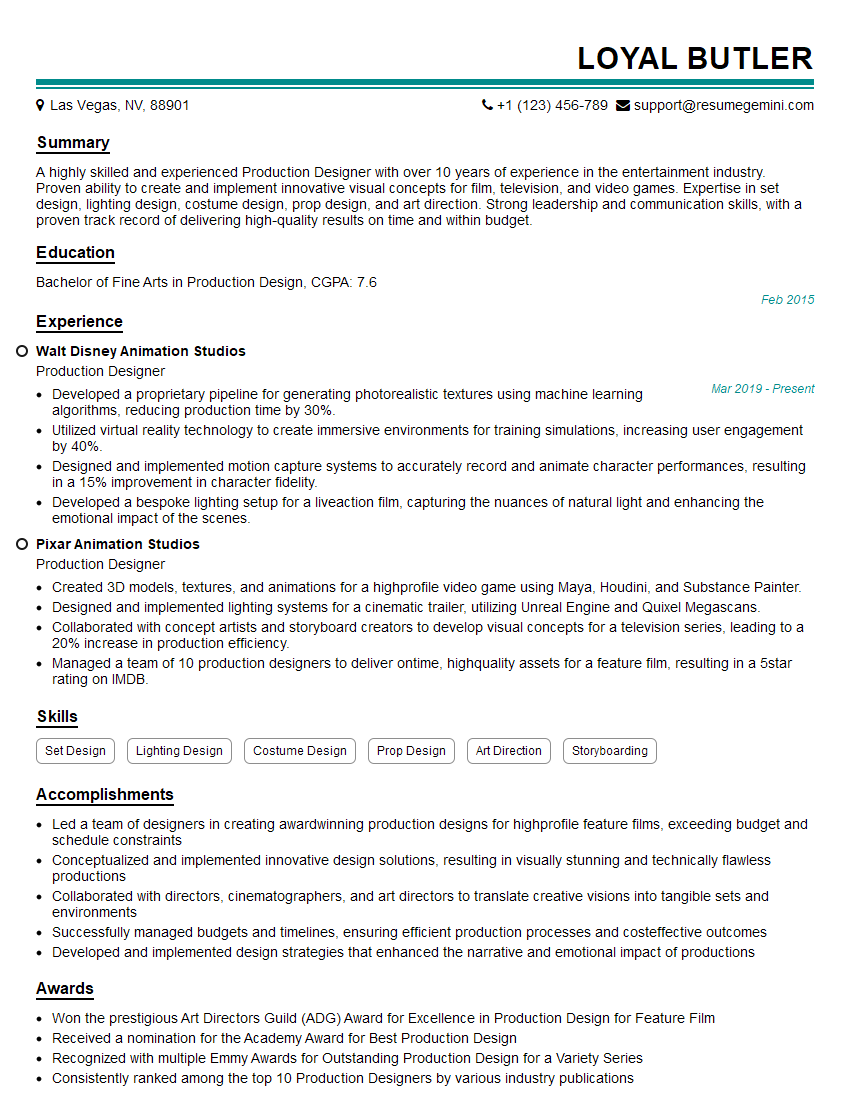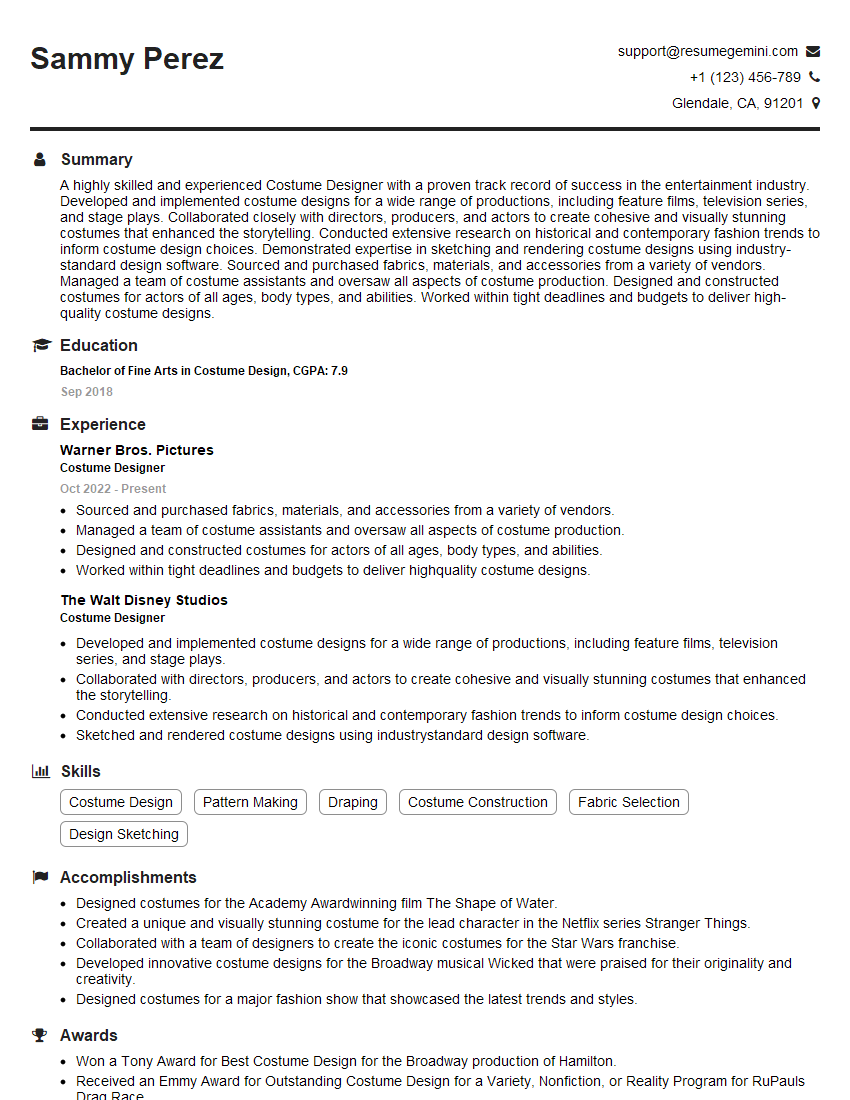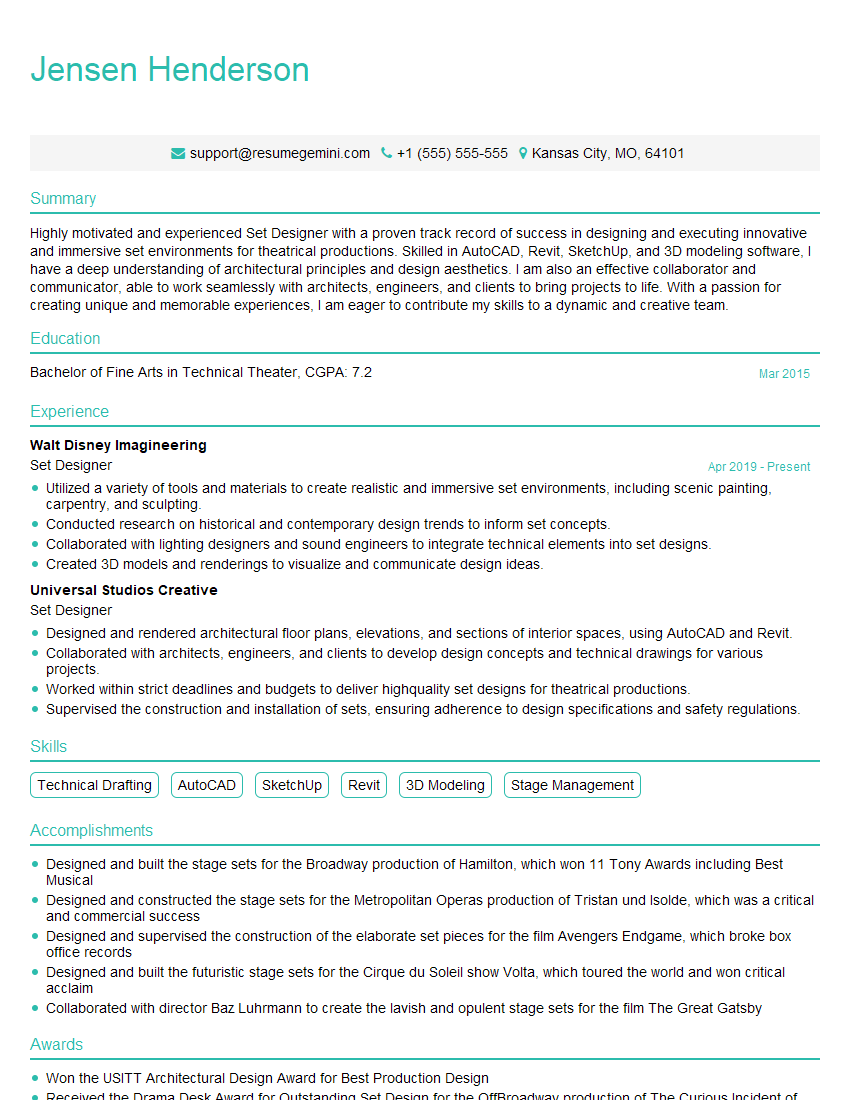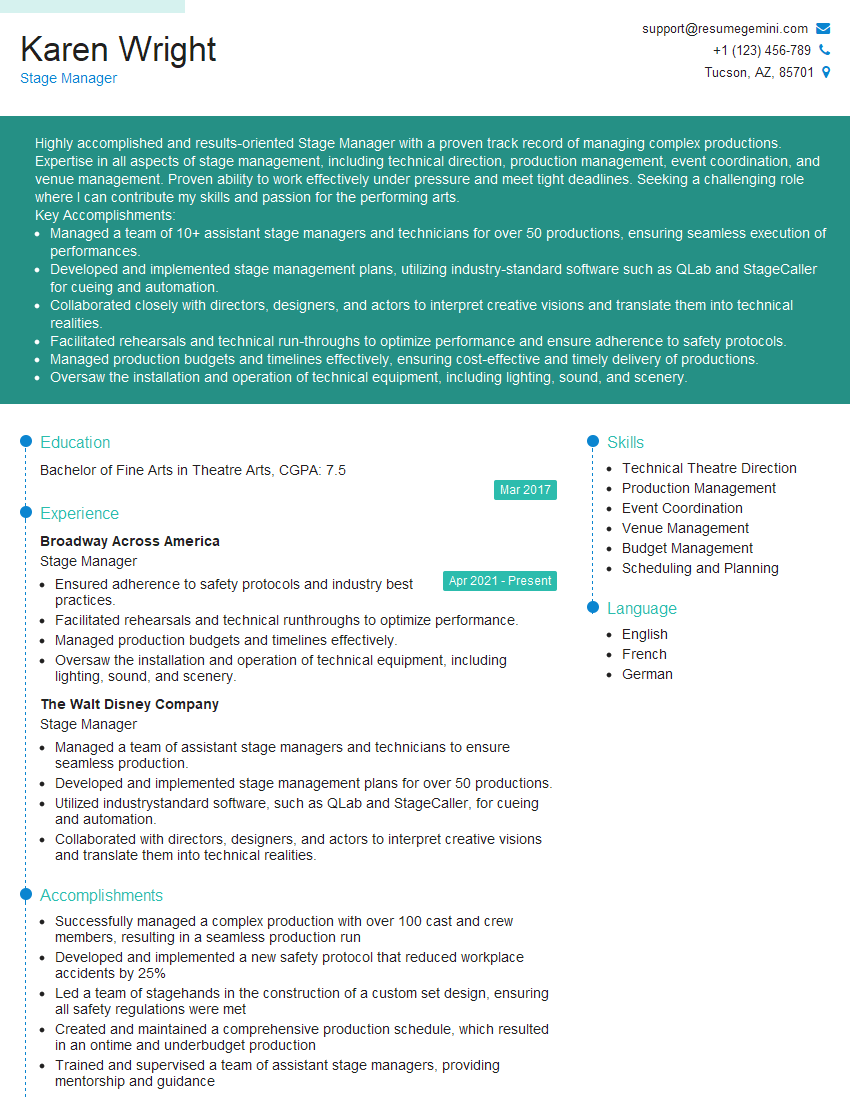Every successful interview starts with knowing what to expect. In this blog, we’ll take you through the top Set and Lighting Design interview questions, breaking them down with expert tips to help you deliver impactful answers. Step into your next interview fully prepared and ready to succeed.
Questions Asked in Set and Lighting Design Interview
Q 1. Explain the difference between a Fresnel and a PAR lamp.
Fresnel and PAR lamps are both widely used in stage lighting, but they differ significantly in their design, light distribution, and applications. A Fresnel lamp features a lens with concentric rings that allows for a smooth, adjustable beam. You can vary its focus from a very wide, soft wash to a tighter, more concentrated spot, making it incredibly versatile. Think of it like adjusting the zoom on a camera lens. Its soft-edged beam is ideal for highlighting actors’ faces or creating washes across a stage. In contrast, a PAR (Parabolic Aluminized Reflector) lamp uses a parabolic reflector to create a sharper, more intense beam. PARs generally don’t offer the same smooth focus adjustment as Fresnels. They’re often used for impactful backlighting, gobo projections (using patterns projected onto the stage), or creating strong, focused beams. Think of a PAR as a spotlight – powerful and precise.
For example, I might use Fresnels for front lighting actors to create a soft, flattering light, and PARs with gobos to project scenic elements onto the backdrop, adding depth and atmosphere.
Q 2. Describe your experience with lighting control consoles (e.g., ETC Ion, MA Lighting grandMA2).
I have extensive experience programming lighting on both ETC Ion and MA Lighting grandMA2 consoles. My proficiency extends beyond basic operation; I’m comfortable using advanced features like cue lists, palettes, and macros to efficiently manage complex lighting designs. On a recent production of Hamlet, I used the ETC Ion to create dynamic lighting cues that mirrored the play’s emotional shifts. The console’s intuitive interface allowed me to swiftly adjust color temperatures and intensities, seamlessly transitioning from intimate scenes to large-scale dramatic moments. I’ve also worked with the MA grandMA2 on several large-scale events, appreciating its power and flexibility for controlling a vast number of fixtures. I’m particularly adept at utilizing its network capabilities for managing multiple universes and integrating with other show control systems.
I’m also comfortable troubleshooting technical issues and working collaboratively with other lighting technicians to ensure smooth operation during rehearsals and performances. The ability to quickly adapt to different consoles and software is crucial in this field, and I’ve consistently demonstrated that adaptability throughout my career.
Q 3. How do you approach designing lighting for a complex, multi-scene play?
Designing lighting for a multi-scene play requires a strategic approach that combines visual storytelling with practical considerations. My process begins with a thorough read-through of the script, identifying key moments, locations, and mood changes. I then collaborate with the director to understand their vision and how lighting can support the narrative and character development. This often involves creating a mood board that helps visualize the overall aesthetic and color palettes.
I would break down the play into distinct scenes or acts, creating individual lighting plots for each. This allows me to develop specific lighting cues that emphasize the emotional arc of each scene. I pay close attention to the transitions between scenes to ensure a smooth and effective flow. Using a lighting plot, a crucial tool, I meticulously document fixture positions, color schemes, and cue details, creating a detailed roadmap that guides both the lighting crew and myself throughout the process. Careful consideration is given to the interplay of light and shadow, ensuring that the lighting design enhances the storytelling and performance without overpowering it.
Q 4. What software are you proficient in for Set and Lighting Design (e.g., Vectorworks, AutoCAD, WYSIWYG)?
My software proficiency encompasses Vectorworks, AutoCAD, and WYSIWYG. Vectorworks is my primary tool for 2D and 3D modeling of stage sets and lighting designs. I find its intuitive interface and robust features ideal for creating detailed visualizations of set pieces and fixture placement. AutoCAD is used for precision drafting and technical drawings, particularly when collaborating with architects or construction crews. WYSIWYG, a lighting design software, allows me to visualize the lighting design in 3D, pre-visualizing the lighting effects before the actual installation. This is vital for complex designs and saves valuable time and resources during rehearsals.
I utilize the software’s capabilities to create photorealistic renderings and lighting simulations, allowing for accurate pre-visualization and effective communication with the production team. This collaborative approach is critical to ensure a seamless and efficient workflow.
Q 5. Explain your understanding of color temperature and its impact on mood.
Color temperature, measured in Kelvin (K), refers to the warmth or coolness of a light source. Lower Kelvin values (e.g., 2700K) represent warmer, more orange-toned light, often associated with candlelight or sunset. Higher Kelvin values (e.g., 6500K) represent cooler, bluer light, similar to daylight. This has a profound impact on mood and atmosphere.
Warm colors create a sense of intimacy, comfort, and nostalgia. Think of a romantic dinner scene illuminated by warm, amber light. Cooler colors, on the other hand, can evoke feelings of serenity, coldness, or even tension. Imagine a suspenseful scene bathed in cool, bluish light. I carefully select color temperatures to enhance the mood and emotional impact of each scene in a production. For instance, in a horror play, cool blues and greens might enhance the suspense, whereas warm, inviting tones would be inappropriate. The skillful manipulation of color temperature is a crucial element of effective lighting design.
Q 6. Describe your experience with rigging and safety protocols.
Rigging and safety are paramount in my work. I’m thoroughly familiar with all relevant safety regulations and best practices for hanging and securing lighting equipment. My experience includes working with various rigging systems, from simple counterweight systems to more complex motorized systems. Before any rigging operation, I meticulously inspect all equipment, ensuring that it’s in perfect working order and properly rated for the weight it will support. I always work with a qualified rigging crew and follow a detailed safety checklist. I’m also skilled in knot-tying and other rigging techniques, ensuring the safety of both the crew and the equipment. We have regular safety meetings on every production, and I participate actively in the discussion and training.
Regular safety inspections, fall protection, and proper load calculations are vital parts of my workflow. Safety is not just a protocol; it’s a fundamental principle that underpins all my work.
Q 7. How do you manage a lighting plot effectively?
Effective management of a lighting plot is essential for a successful production. I begin by creating a clear and organized document that details the position of each fixture, its type, color, and function. This plot serves as a blueprint for the lighting crew, ensuring consistent implementation of the design. I use a standardized system of labeling and numbering fixtures to minimize confusion. Software like WYSIWYG helps to visualize and manage the plot effectively. In addition to the physical plot, I also create a digital version, often using a spreadsheet or database to track cue information, including color, intensity, and gobo patterns for each fixture.
Regular updates and revisions are crucial, especially during rehearsals. I frequently collaborate with the director, stage manager, and other lighting technicians to address any changes or adjustments needed. Clear communication and detailed documentation are key to maintaining a well-organized and readily accessible lighting plot throughout the production process.
Q 8. What is your process for creating a set design from an initial concept?
My set design process begins with a deep dive into the script. I analyze the themes, characters, and key moments to understand the story’s essence. This informs my initial concept, which I then develop through several stages. First, I create rough sketches and mood boards, exploring different stylistic approaches and potential set pieces. This is followed by more detailed sketches, incorporating scale and spatial relationships. I then move to technical drawings, using software like Vectorworks or AutoCAD, to create precise plans and elevations for construction. Finally, I create detailed model builds, sometimes using 3D modeling software, to visualize the final product and identify potential issues before construction begins. For example, in designing a set for a gothic horror play, my initial concept might involve towering gothic arches, dimly lit spaces, and strategically placed shadows to create a sense of unease. The technical drawings would then meticulously specify the dimensions of these arches, the materials used, and the placement of lighting fixtures.
Q 9. How do you collaborate effectively with other departments (e.g., costumes, sound)?
Collaboration is paramount in theatre. I believe in open communication and proactive engagement with other departments from the very beginning of the project. With the costume designer, I discuss the color palettes, textures, and overall style of the costumes to ensure they complement the set design. This might involve sharing mood boards and technical drawings to ensure visual harmony. Similarly, with the sound designer, I coordinate the placement of microphones and speakers to avoid conflicts with set pieces and ensure optimal audio quality. A pre-production meeting where all departments present their designs and discuss potential challenges is invaluable. For instance, if the sound designer plans on using low-frequency sounds, I would design the set with materials that can absorb sound vibrations to prevent unintended amplification. This collaborative approach ensures a cohesive and unified production.
Q 10. Explain your understanding of different types of theatrical gels.
Theatrical gels are colored filters placed in front of lighting instruments to modify the color of light. They’re categorized by color temperature and color saturation. Common types include:
- CTO (Color Temperature Orange): Used to warm up the color temperature of a light source.
- CTB (Color Temperature Blue): Used to cool down the color temperature of a light source.
- Roscolux, Lee Filters, and Apollo: These are brands that offer a wide range of colors, from subtle pastels to vibrant hues. Each brand has its own unique color chart and characteristics. For instance, Roscolux has a wide selection of saturated colors while Lee filters are known for their accurate color representation.
- Diffusions: These gels aren’t colored but soften and diffuse the light, reducing harsh shadows. Examples include Frost and Opal.
Understanding the different properties of these gels is crucial for achieving the desired mood and atmosphere on stage. Choosing the right gel can drastically alter the overall look and feel of a scene.
Q 11. Describe your experience with drafting and technical drawings.
I’m proficient in both hand-drafting and using CAD software for technical drawings. Hand-drafting allows for quick sketches and initial concept exploration, useful in brainstorming sessions. However, for precise construction documents and detailed specifications, I rely on CAD software. My experience includes using Vectorworks and AutoCAD to create detailed scale drawings, including floor plans, elevations, sections, and details of set pieces. These drawings are essential for the construction crew, ensuring the set is built accurately and efficiently. For example, a detailed section drawing of a complex staircase would clearly show the dimensions, material specifications, and construction techniques needed by the carpenters.
Q 12. How do you handle unexpected technical issues during a performance?
Dealing with technical issues during a performance requires quick thinking and a calm demeanor. My approach involves assessing the problem swiftly and identifying a solution, prioritizing safety and minimizing disruption to the performance. This might involve having backup equipment readily available, knowing alternative lighting cues, or having a simple repair readily done. For example, if a light fixture malfunctions, I’d immediately switch to a backup light, and if a set piece breaks unexpectedly, I’d work with the stage crew to implement a temporary fix that doesn’t compromise safety. Prior planning and well-rehearsed procedures are key. Regular maintenance checks of equipment are crucial in preventing malfunctions, or having a detailed backup plan in place.
Q 13. Explain your approach to creating a mood board for a set or lighting design.
Creating a mood board is a crucial step in the design process. It’s a visual representation of the desired atmosphere and style, serving as a reference point throughout the project. My approach involves gathering images, textures, color swatches, and even fabric samples that capture the essence of the production. These might include pictures of existing sets, architectural details, artwork, photographs, and even natural scenery. I arrange these elements on a board, digitally or physically, exploring different combinations and relationships to refine the visual language. For example, for a futuristic play, my mood board might include images of sleek metallic surfaces, neon lights, and minimalist architecture, along with a color palette dominated by cool blues and greens.
Q 14. What are some common challenges faced in set and lighting design, and how have you overcome them?
Some common challenges include budget constraints, time limitations, and unforeseen technical difficulties. Budget limitations often require creative problem-solving, finding cost-effective materials and construction techniques without compromising the artistic vision. For instance, I might substitute expensive wood with more affordable alternatives, ensuring the visual effect remains consistent. Tight deadlines necessitate efficient planning and organization, utilizing pre-fabricated elements and streamlining the construction process. Technical challenges, such as lighting fixture malfunctions, are addressed by having backup equipment and well-rehearsed contingency plans. Effective communication with the production team is essential in overcoming these challenges. Collaboration and open discussions, finding alternative solutions, and having backup plans in place are crucial for success.
Q 15. Describe your experience working with different types of stage materials (e.g., wood, metal, fabrics).
My experience spans a wide range of stage materials, each presenting unique challenges and opportunities. Wood, for instance, offers warmth and a classic aesthetic, but requires careful consideration of weight and potential warping. I’ve used it extensively in creating traditional proscenium arches and period-specific sets. Metal, on the other hand, provides strength and versatility—ideal for creating intricate structures or modern, industrial looks. However, it necessitates precise welding and fabrication techniques, along with careful safety precautions. Finally, fabrics offer unparalleled flexibility in terms of texture, color, and drape. I’ve used them to create everything from flowing curtains and backdrops to complex costumes and set pieces. The key is understanding the properties of each material and how they interact with lighting. For example, a heavy velvet drape will absorb light differently than a sheer silk fabric, influencing my lighting design choices.
One project that highlights this was a production of Macbeth where we used rough-hewn wooden planks to create a gritty, claustrophobic atmosphere, juxtaposed against flowing black silk curtains to represent the supernatural elements. Understanding the weight and structural properties of the wood was crucial in ensuring the safety and stability of the set. Similarly, the choice of black silk allowed for the controlled absorption and reflection of light to enhance the dramatic mood.
Career Expert Tips:
- Ace those interviews! Prepare effectively by reviewing the Top 50 Most Common Interview Questions on ResumeGemini.
- Navigate your job search with confidence! Explore a wide range of Career Tips on ResumeGemini. Learn about common challenges and recommendations to overcome them.
- Craft the perfect resume! Master the Art of Resume Writing with ResumeGemini’s guide. Showcase your unique qualifications and achievements effectively.
- Don’t miss out on holiday savings! Build your dream resume with ResumeGemini’s ATS optimized templates.
Q 16. How familiar are you with theatrical safety regulations?
Theatrical safety is paramount, and I’m intimately familiar with all relevant regulations. My understanding encompasses fire safety (proper use of flame retardant materials, emergency exits, clear escape routes), electrical safety (proper wiring, grounding, and use of safety equipment), and rigging safety (secure hanging points, weight limits, and safe handling practices). I always prioritize safety during every stage of the design process, from initial concept to strike. I collaborate closely with stage managers and technicians to ensure that all safety protocols are followed and that potential hazards are identified and mitigated proactively. I’m also trained in first aid and emergency response procedures, just in case.
For example, in a recent musical, we incorporated pyrotechnics. The design process meticulously followed all fire safety regulations, including using certified technicians, having a detailed safety plan approved by the venue, and ensuring that all actors received thorough training and were equipped with safety harnesses. Every detail was planned and practiced to avoid any unforeseen accidents.
Q 17. Explain your understanding of light diffusion and its application in design.
Light diffusion refers to the scattering of light, softening harsh shadows and creating a more even distribution of illumination. It’s achieved using various materials and techniques. Diffusers, such as frosted gels, diffusion filters, or scrims, spread light over a wider area, reducing contrast and intensity. The level of diffusion affects the mood and aesthetic significantly. A highly diffused light creates a soft, romantic ambiance, while less diffusion results in sharper, more dramatic lighting. Understanding this is crucial for manipulating the mood, highlighting specific areas, and creating depth on stage.
In practical terms, imagine a spotlight shining directly on an actor’s face. Without diffusion, you’d get a harsh spotlight effect. By adding a diffusion filter, we can soften the light, making it more flattering and less intense. This principle applies to various light fixtures—from spotlights to washes. The choice of diffusion material depends on the specific effect desired and the intensity of the light source.
Q 18. Describe your experience working with moving lights.
I have extensive experience programming and operating moving lights, including fixtures from major manufacturers like Robe, Martin, and ETC. My expertise covers various types of moving lights, including automated spotlights, beam projectors, and wash fixtures. I’m proficient in utilizing their various functionalities such as gobo projection, color mixing, and beam shaping to create dynamic and engaging visual effects. I’m also familiar with different control consoles and programming software, allowing me to create complex lighting cues and sequences efficiently.
For instance, in a recent dance performance, I used moving lights to create dynamic patterns and textures, highlighting the choreography and immersing the audience in the movement. By utilizing the pan and tilt functions, gobo projections, and color mixing capabilities of the moving lights, I was able to follow the dancers seamlessly and create a visually captivating experience. The ability to program complex light shows and quickly make adjustments on the fly is crucial in live performance, which I’ve honed over the years.
Q 19. How do you balance artistic vision with practical constraints (e.g., budget, time)?
Balancing artistic vision with practical constraints is a core skill in set and lighting design. It requires a pragmatic approach where I explore creative solutions within budgetary and time limitations. This often involves prioritizing key elements of the design, making strategic choices regarding materials and techniques, and seeking cost-effective alternatives without compromising the overall artistic integrity. Open communication with the director and production team is essential throughout the process.
For example, on a low-budget production, instead of building expensive custom-designed set pieces, I might opt for repurposing existing materials or using creative projections to create the illusion of complex scenery. This allows me to maintain the artistic vision while staying within the budget. Time constraints might necessitate simplifying certain design elements or utilizing faster construction techniques.
Q 20. Explain your process for creating scale models or renderings of a set.
My process for creating scale models and renderings begins with thorough research and conceptual sketching. I start by developing initial concepts and sketches based on the script and director’s vision. Then, I create a scale model, usually a miniature representation of the set, using materials such as foam core, balsa wood, and paint. This allows for physical exploration and visualization of spatial relationships. Simultaneously, I create digital renderings using software like Vectorworks or AutoCAD to further refine the design and generate detailed plans for construction. These 3D models allow for precise measurements, lighting simulations, and presentation to stakeholders.
The models provide a tangible representation for collaborative feedback with the director and other designers. They offer a means to solve potential spatial problems before construction even begins and to visualize the intended aesthetics in three dimensions. The renderings, meanwhile, help communicate the final design to the construction team, providing detailed technical drawings and lighting plots.
Q 21. How do you incorporate sustainability into your set and lighting designs?
Sustainability is a growing concern in the theatre industry, and I actively incorporate sustainable practices in my set and lighting designs. This includes choosing environmentally friendly materials whenever possible, such as reclaimed wood, recycled fabrics, and sustainably sourced lumber. I prioritize designs that minimize waste by using modular set pieces that can be reused or repurposed for future productions. I also focus on energy-efficient lighting solutions, utilizing LED fixtures that consume less energy and have a longer lifespan than traditional incandescent or halogen lights.
Furthermore, I collaborate with local organizations or recycling centers to donate or recycle materials at the end of a production’s run. This holistic approach minimizes the environmental impact of our productions, promoting a more environmentally responsible theatre industry. For example, in a recent production, we used reclaimed scaffolding to create a unique set design, resulting in a cost-effective and environmentally friendly choice.
Q 22. Describe your experience with creating and implementing lighting cues.
Creating and implementing lighting cues involves a meticulous process, from initial concept to final execution. It begins with understanding the director’s vision and translating that into a visual language of light. This includes selecting the appropriate lighting instruments, determining their positions, and programming their functions within a lighting console.
For example, in a recent production of Hamlet, I designed a series of cues to highlight the emotional shifts within the play. A single, stark spotlight for Hamlet’s soliloquies contrasted with a warmer, more diffused wash for scenes of courtly intrigue. Each cue was meticulously programmed to fade in and out smoothly, emphasizing the nuances of the character’s emotional journey.
The implementation phase involves close collaboration with the lighting crew. I meticulously document each cue’s parameters, ensuring accurate execution and troubleshooting potential issues during rehearsals and performances. This might involve creating detailed cue lists, plotting the positions of the fixtures, and providing clear instructions on color temperature, intensity, and movement. A smooth transition between cues is vital to avoid jarring the audience and maintain the dramatic flow of the production.
Q 23. What is your experience with different types of theatrical scenery (e.g., flats, drops, cycloramas)?
My experience encompasses a wide range of theatrical scenery. I’ve worked extensively with flats, which are essentially painted panels creating walls and backgrounds. I understand the importance of their construction, how they can be used to create depth and perspective, and how lighting interacts with their textures and colors.
Drops, large painted cloths hung from the ceiling, provide a more painterly backdrop, often used to establish location or atmosphere. Cycloramas, curved backdrops, are exceptionally versatile, allowing for spectacular effects, especially with backlighting, creating atmospheric washes and even projections. My experience extends to working with these elements individually and in conjunction, ensuring they complement each other and contribute to a cohesive visual narrative. For instance, in a recent musical, we used flats to represent the interior of a café, while a cyclorama behind them depicted a vibrant city nightscape. Lighting was crucial in blending these elements seamlessly.
Q 24. How do you ensure accessibility in your set and lighting designs?
Accessibility is paramount in my design process. This includes considerations for audience members with visual or auditory impairments and performers with mobility challenges. For audience members, this might involve ensuring sufficient lighting levels in walkways and seating areas, providing audio description services, and incorporating visual cues like flashing lights or captions for those with hearing impairments.
For performers, I consider providing appropriate lighting levels and avoiding strobe effects that might trigger seizures. Set design should consider wheelchair accessibility for both performers and audience members. I consult with accessibility specialists and ensure that all design choices are inclusive, promoting a welcoming and accessible experience for everyone.
Q 25. Describe your experience with designing lighting for different performance spaces (e.g., proscenium, thrust, arena).
Designing lighting for different performance spaces requires adaptability. Proscenium stages, with their traditional arch, offer a clear sightline, making lighting placement straightforward. Thrust stages, extending into the audience, require more careful consideration of light placement to avoid blinding audience members. Arena stages, with the audience surrounding the performance area, pose the greatest challenge, demanding creative solutions for light placement and direction to ensure even coverage and visibility.
For instance, in a proscenium production, I might use front-of-house lighting more extensively. On a thrust stage, I’d strategically place lights closer to the audience to highlight the actors and keep the audience engaged. An arena stage performance would rely heavily on overhead lighting and carefully positioned side lighting to balance the visibility without creating harsh shadows. Each space necessitates a different approach, requiring a thorough understanding of its unique properties.
Q 26. How do you adapt your design process based on the specific requirements of a production?
My design process is highly adaptable. I begin by thoroughly understanding the production’s specific requirements—the script’s themes, the director’s vision, the budget, and the venue’s limitations. This involves detailed discussions with the director, designers, and production team.
For example, a low-budget production might require creative solutions using readily available lighting equipment, while a large-scale production would allow for more elaborate designs. The style of the play itself dictates the lighting approach; a naturalistic drama will demand a different aesthetic than an avant-garde piece. My design process is iterative, allowing for revisions based on feedback and the evolution of the production during rehearsals.
Q 27. Explain your familiarity with different types of dimmer systems.
My familiarity with dimmer systems extends across various types, including analog dimmers, which control light intensity using variable resistors, and digital dimmers, offering greater precision and control via computer interfaces. Modern digital dimmer systems, like those using DMX (Digital Multiplex) protocol, are preferred for their precision, flexibility, and ease of programming.
Understanding the capabilities and limitations of different systems is crucial. For example, analog dimmers might introduce some noise or flicker, which is less likely with high-quality digital dimmers. I also have experience with various control protocols, such as DMX512 and RDM (Remote Device Management), allowing for extensive control and monitoring of lighting fixtures. This enables precise adjustments and efficient troubleshooting during the production.
Q 28. Describe your problem-solving approach when encountering conflicts between lighting and set design elements.
Conflicts between lighting and set design are inevitable, but readily addressed through collaborative problem-solving. My approach is to establish clear communication from the start, holding regular meetings with the set designer to discuss potential issues and find mutually agreeable solutions.
For example, if the set designer plans a large, dark element that interferes with lighting placement, we might explore alternative positions for the lighting fixtures or adjust the set piece’s dimensions. Sometimes, this involves rethinking the lighting design to work around set elements. Compromise is key, prioritizing the overall artistic vision of the production. Ultimately, the goal is to create a visually cohesive and unified experience for the audience, where lighting and set design work harmoniously.
Key Topics to Learn for Set and Lighting Design Interview
- Space Planning & Design: Understanding the relationship between set design, audience perspective, and actor movement. Practical application: Sketching and model-making to demonstrate spatial awareness and design solutions.
- Lighting Design Principles: Mastering the use of light to create mood, atmosphere, and highlight key elements of the production. Practical application: Explaining how different lighting instruments (e.g., Fresnels, ellipsoidal reflectors) achieve specific effects.
- Color Theory & Lighting Design: Understanding how color temperature, saturation, and hue impact the overall visual experience. Practical application: Discussing color palettes and their emotional impact on the audience.
- Technical Aspects of Lighting: Familiarity with lighting consoles, dimmer boards, and other technical equipment. Practical application: Demonstrating knowledge of lighting plots, cue sheets, and patching techniques.
- Set Construction & Materials: Understanding different construction methods, materials, and their properties. Practical application: Describing how specific materials influence the overall aesthetic and functionality of a set.
- Collaboration & Communication: Highlighting the importance of teamwork and effective communication with directors, other designers, and technical crews. Practical application: Providing examples of how you’ve worked collaboratively to achieve a shared artistic vision.
- Budgeting & Resource Management: Understanding the practical aspects of managing resources effectively within budgetary constraints. Practical application: Demonstrating an understanding of cost-effective design solutions.
- Safety Regulations & Procedures: Demonstrating awareness of safety protocols related to set construction, lighting equipment, and theatrical environments. Practical application: Describing how you ensure safe working practices on a production.
Next Steps
Mastering Set and Lighting Design opens doors to a dynamic and creative career in theatre, film, television, and beyond. Your skills are in high demand! To significantly increase your job prospects, crafting a strong, ATS-friendly resume is crucial. ResumeGemini is a trusted resource that can help you build a professional resume that highlights your unique skills and experience. They even provide examples of resumes tailored to Set and Lighting Design to give you a head start. Invest time in crafting a compelling resume – it’s your first impression on potential employers.
Explore more articles
Users Rating of Our Blogs
Share Your Experience
We value your feedback! Please rate our content and share your thoughts (optional).
What Readers Say About Our Blog
Hello,
We found issues with your domain’s email setup that may be sending your messages to spam or blocking them completely. InboxShield Mini shows you how to fix it in minutes — no tech skills required.
Scan your domain now for details: https://inboxshield-mini.com/
— Adam @ InboxShield Mini
Reply STOP to unsubscribe
Hi, are you owner of interviewgemini.com? What if I told you I could help you find extra time in your schedule, reconnect with leads you didn’t even realize you missed, and bring in more “I want to work with you” conversations, without increasing your ad spend or hiring a full-time employee?
All with a flexible, budget-friendly service that could easily pay for itself. Sounds good?
Would it be nice to jump on a quick 10-minute call so I can show you exactly how we make this work?
Best,
Hapei
Marketing Director
Hey, I know you’re the owner of interviewgemini.com. I’ll be quick.
Fundraising for your business is tough and time-consuming. We make it easier by guaranteeing two private investor meetings each month, for six months. No demos, no pitch events – just direct introductions to active investors matched to your startup.
If youR17;re raising, this could help you build real momentum. Want me to send more info?
Hi, I represent an SEO company that specialises in getting you AI citations and higher rankings on Google. I’d like to offer you a 100% free SEO audit for your website. Would you be interested?
Hi, I represent an SEO company that specialises in getting you AI citations and higher rankings on Google. I’d like to offer you a 100% free SEO audit for your website. Would you be interested?
good

